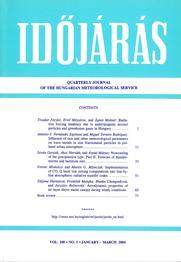IDŐJÁRÁS - angol nyelvű folyóirat
Vol. 108, No. 1 * Pages 1–77 * January - March 2004
 |
|
 letöltés [pdf: 31393 KB]
letöltés [pdf: 31393 KB]
Radiative forcing tendency due to anthropogenic aerosol particles and greenhouse gases in Hungary
Feckó Tivadar, Mészáros Ernő, Molnár Ágnes
idojaras.2004.1.1 (p. 1–)
Feckó Tivadar, Mészáros Ernő, Molnár Ágnes
idojaras.2004.1.1 (p. 1–)
Influence of rain and other meteorological parameters on trace metals in size fractionated particles in polluted urban atmosphere
Espinosa, A.J.F., Rodríguez, T.M.
idojaras.2004.1.2 (p. 11–)
Espinosa, A.J.F., Rodríguez, T.M.
idojaras.2004.1.2 (p. 11–)
Nowcasting of the precipitation type Part II: Forecast of thunderstorms and hailstone size
Geresdi István, Horváth Ákos, Mátyus Árpád
idojaras.2004.1.3 (p. 33–)
Geresdi István, Horváth Ákos, Mátyus Árpád
idojaras.2004.1.3 (p. 33–)
Implementation of CO2 Q band line mixing computations into line-by-line atmospheric radiative transfer codes
Miskolczi Ferenc, Mlynczak, M.G.
idojaras.2004.1.4 (p. 51–)
Miskolczi Ferenc, Mlynczak, M.G.
idojaras.2004.1.4 (p. 51–)
Aerodynamic properties of air layer above maize canopy during windy conditions
Hurtalová, T., Matejka, F., Chalupníková, B., Rožnovský, J.
idojaras.2004.1.5 (p. 65–)
Hurtalová, T., Matejka, F., Chalupníková, B., Rožnovský, J.
idojaras.2004.1.5 (p. 65–)
IDŐJÁRÁS folyóirat

Az IDŐJÁRÁS a HungaroMet Nonprofit Zrt. negyedévenként megjelenő angol nyelvű folyóirata
Megrendelhető a journal.idojaras@met.hu címen.
A szerzőknek szánt útmutató itt olvasható.
Megrendelhető a journal.idojaras@met.hu címen.
A szerzőknek szánt útmutató itt olvasható.









